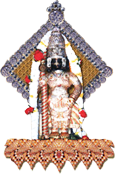स्पर्शान् कृत्वा बहिः बाह्यान् चक्षुः च एव अन्तरॆ भ्रुवॊः ।
प्राण अपानौ समौ कृत्वा नासाभ्यन्तर चारिणौ ॥ ५.२७ ॥
यत इन्द्रिय मनः बुद्धिः मुनिः मॊक्ष परायणः ।
विगत इच्छा भय क्रॊधः यः सदा मुक्त एव सः ॥ ५.२८ ॥
ಸ್ಪರ್ಶಾನ್ ಕೃತ್ವಾ ಬಹಿಃ ಬಾಹ್ಯಾನ್ ಚಕ್ಷುಃ ಚ ಏವ ಅಂತರೇ ಭ್ರುವೋಃ |
ಪ್ರಾಣ ಅಪಾನೌ ಸಮೌ ಕೃತ್ವಾ ನಾಸಾಭ್ಯಂತರ ಚಾರಿಣೌ || ೫.೨೭ ||
ಯತ ಇಂದ್ರಿಯ ಮನಃ ಬುದ್ಧಿಃ ಮುನಿಃ ಮೋಕ್ಷ ಪರಾಯಣಃ |
ವಿಗತ ಇಚ್ಛಾ ಭಯ ಕ್ರೋಧಃ ಯಃ ಸದಾ ಮುಕ್ತ ಏವ ಸಃ || ೫.೨೮ ||
sparshAn kRutvA bahiH bAhyAn chakShuH cha eva antarE bhruvOH |
prANa apAnau samau kRutvA nAsAbhyantara chAriNau || 5.27 ||
yata indriya manaH buddhiH muniH mOkSha parAyaNaH |
vigata icChA bhaya krOdhaH yaH sadA mukta eva saH || 5.28 ||
Having made the external contacts purely external and fixed the sight only between the eyebrows, and having balanced praaNa apaana that are passing through the nostrils,
The contemplatist who intent upon release, has controlled his mind, reason and other senses, and who is always free from desire, fear and anger, he is certainly the released one.
In these two verses Lord Krishna describes the perfected method of meditation for achieving moksha or release from the material existence. The method commences by turning inward with the mind away from all external sense objects associated with sight, sound, taste, smell and touch. Then one fixes the vision internally between the eyebrows; simultaneously and slowly controlling the inhalation and exhalation; and pausing in between the two states, in kumbhaka.


